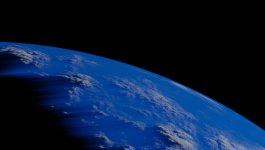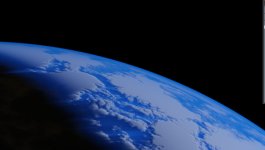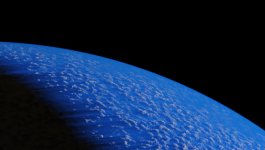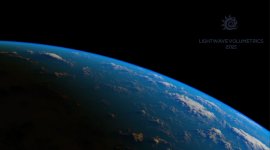prometheus
REBORN
Just sharing if someone feels to discuss the volumetric system, what can be improved or what I did here and there, pro´s and cons etc.
mostly just screenshots of never finished never ending experiments, some of them not fully iterated to full quality, but you get the idea, most of these are quite big in scale trying to match real world scale clouds, unlike the provided LW content.
Everything here is just volumetric clouds, no photos involved.
Planet clouds are shape item and volume item, at real earth diameter size and the cloud sphere is the same, fully volumetric as well, though this one should be more smoother in density, I think I have much better stuff in there, but didn´t take screenshots of those yet, it´s like 191 incremental scenefiles for planet clouds, so I have a lot to go trough only for planet clouds, and just imagine everything else.
Various moods from feather clouds, godrays etc, fog and almost sunsets, some godrays, like that over water is global scattering, all distant suns, always tricky to get those right with volumetric distance, and if not careful edge dark clipping can occour as in this case to demonstrate that, you can adjust that by pulling back volumetric distance, as well as adjusting the actual textures to be more soft, with curves for instance.
Other godrays as the one with more fog in the bottom, that is not global volumetric scattering, but a fog volumetric items, so I can control groung fog and set a mood similar to real behavior where it fades up higher in the sky but yet tinting it redish orange green to some degree, and I do not have to worry about clipping as global scattering, nor volumetric distance settings.
there is no global illumination in anyone of these images, in these two first, you can see the difference between one cloud with environment light to help illuminated the back part where light isn´t penetrating and one without and how that looks like.
As always, we miss fast renders with GPU and a truly proper volume bounce multiple scatter method, and we miss infinite cloud layers as well, and spectra atmosphere..and, well enough for now.
[url=https://flic.kr/p/2kW8Ger] ScreenShot 03-11-21 at 02.51.26 PM by Michael Ivarsson, on Flickr[/URL]
ScreenShot 03-11-21 at 02.51.26 PM by Michael Ivarsson, on Flickr[/URL]
[url=https://flic.kr/p/2kW8Ga8] ScreenShot 03-11-21 at 03.54.41 AM by Michael Ivarsson, on Flickr[/URL]
ScreenShot 03-11-21 at 03.54.41 AM by Michael Ivarsson, on Flickr[/URL]
[url=https://flic.kr/p/2kW43bj] ScreenShot 03-10-21 at 06.52.22 AM by Michael Ivarsson, on Flickr[/URL]
ScreenShot 03-10-21 at 06.52.22 AM by Michael Ivarsson, on Flickr[/URL]
[url=https://flic.kr/p/2kWda92] ScreenShot 03-10-21 at 11.54.35 PM by Michael Ivarsson, on Flickr[/URL]
ScreenShot 03-10-21 at 11.54.35 PM by Michael Ivarsson, on Flickr[/URL]
[url=https://flic.kr/p/2kW7uup] ScreenShot 12-31-20 at 04.46.22 PM by Michael Ivarsson, on Flickr[/URL]
ScreenShot 12-31-20 at 04.46.22 PM by Michael Ivarsson, on Flickr[/URL]
[url=https://flic.kr/p/2kWbwmA] ScreenShot 01-18-21 at 07.22.12 PM by Michael Ivarsson, on Flickr[/URL]
ScreenShot 01-18-21 at 07.22.12 PM by Michael Ivarsson, on Flickr[/URL]
[url=https://flic.kr/p/2kWbwqZ] ScreenShot 01-18-21 at 02.46.38 PM by Michael Ivarsson, on Flickr[/URL]
ScreenShot 01-18-21 at 02.46.38 PM by Michael Ivarsson, on Flickr[/URL]
[url=https://flic.kr/p/2kW8Gss] Layout_IvXjpBne1N by [/URL]
Layout_IvXjpBne1N by [/URL]
[url=https://www.flickr.com/photos/187886675@N08/]Michael Ivarsson, on Flickr[/URL]
[url=https://flic.kr/p/2kWbwLJ] ScreenShot 04-28-21 at 06.51.31 AM by Michael Ivarsson, on Flickr[/URL]
ScreenShot 04-28-21 at 06.51.31 AM by Michael Ivarsson, on Flickr[/URL]
[url=https://flic.kr/p/2kWda11] ScreenShot 04-28-21 at 02.28.31 AM by Michael Ivarsson, on Flickr[/URL]
ScreenShot 04-28-21 at 02.28.31 AM by Michael Ivarsson, on Flickr[/URL]
[url=https://flic.kr/p/2kWbw7Y] ScreenShot 12-28-20 at 02.24.48 AM by Michael Ivarsson, on Flickr[/URL]
ScreenShot 12-28-20 at 02.24.48 AM by Michael Ivarsson, on Flickr[/URL]
[url=https://flic.kr/p/2kWbwv8] ScreenShot 01-09-21 at 08.15.21 PM by Michael Ivarsson, on Flickr[/URL]
ScreenShot 01-09-21 at 08.15.21 PM by Michael Ivarsson, on Flickr[/URL]
mostly just screenshots of never finished never ending experiments, some of them not fully iterated to full quality, but you get the idea, most of these are quite big in scale trying to match real world scale clouds, unlike the provided LW content.
Everything here is just volumetric clouds, no photos involved.
Planet clouds are shape item and volume item, at real earth diameter size and the cloud sphere is the same, fully volumetric as well, though this one should be more smoother in density, I think I have much better stuff in there, but didn´t take screenshots of those yet, it´s like 191 incremental scenefiles for planet clouds, so I have a lot to go trough only for planet clouds, and just imagine everything else.
Various moods from feather clouds, godrays etc, fog and almost sunsets, some godrays, like that over water is global scattering, all distant suns, always tricky to get those right with volumetric distance, and if not careful edge dark clipping can occour as in this case to demonstrate that, you can adjust that by pulling back volumetric distance, as well as adjusting the actual textures to be more soft, with curves for instance.
Other godrays as the one with more fog in the bottom, that is not global volumetric scattering, but a fog volumetric items, so I can control groung fog and set a mood similar to real behavior where it fades up higher in the sky but yet tinting it redish orange green to some degree, and I do not have to worry about clipping as global scattering, nor volumetric distance settings.
there is no global illumination in anyone of these images, in these two first, you can see the difference between one cloud with environment light to help illuminated the back part where light isn´t penetrating and one without and how that looks like.
As always, we miss fast renders with GPU and a truly proper volume bounce multiple scatter method, and we miss infinite cloud layers as well, and spectra atmosphere..and, well enough for now.
[url=https://flic.kr/p/2kW8Ger]
 ScreenShot 03-11-21 at 02.51.26 PM by Michael Ivarsson, on Flickr[/URL]
ScreenShot 03-11-21 at 02.51.26 PM by Michael Ivarsson, on Flickr[/URL][url=https://flic.kr/p/2kW8Ga8]
 ScreenShot 03-11-21 at 03.54.41 AM by Michael Ivarsson, on Flickr[/URL]
ScreenShot 03-11-21 at 03.54.41 AM by Michael Ivarsson, on Flickr[/URL][url=https://flic.kr/p/2kW43bj]
 ScreenShot 03-10-21 at 06.52.22 AM by Michael Ivarsson, on Flickr[/URL]
ScreenShot 03-10-21 at 06.52.22 AM by Michael Ivarsson, on Flickr[/URL][url=https://flic.kr/p/2kWda92]
 ScreenShot 03-10-21 at 11.54.35 PM by Michael Ivarsson, on Flickr[/URL]
ScreenShot 03-10-21 at 11.54.35 PM by Michael Ivarsson, on Flickr[/URL][url=https://flic.kr/p/2kW7uup]
 ScreenShot 12-31-20 at 04.46.22 PM by Michael Ivarsson, on Flickr[/URL]
ScreenShot 12-31-20 at 04.46.22 PM by Michael Ivarsson, on Flickr[/URL][url=https://flic.kr/p/2kWbwmA]
 ScreenShot 01-18-21 at 07.22.12 PM by Michael Ivarsson, on Flickr[/URL]
ScreenShot 01-18-21 at 07.22.12 PM by Michael Ivarsson, on Flickr[/URL][url=https://flic.kr/p/2kWbwqZ]
 ScreenShot 01-18-21 at 02.46.38 PM by Michael Ivarsson, on Flickr[/URL]
ScreenShot 01-18-21 at 02.46.38 PM by Michael Ivarsson, on Flickr[/URL][url=https://flic.kr/p/2kW8Gss]
 Layout_IvXjpBne1N by [/URL]
Layout_IvXjpBne1N by [/URL][url=https://www.flickr.com/photos/187886675@N08/]Michael Ivarsson, on Flickr[/URL]
[url=https://flic.kr/p/2kWbwLJ]
 ScreenShot 04-28-21 at 06.51.31 AM by Michael Ivarsson, on Flickr[/URL]
ScreenShot 04-28-21 at 06.51.31 AM by Michael Ivarsson, on Flickr[/URL][url=https://flic.kr/p/2kWda11]
 ScreenShot 04-28-21 at 02.28.31 AM by Michael Ivarsson, on Flickr[/URL]
ScreenShot 04-28-21 at 02.28.31 AM by Michael Ivarsson, on Flickr[/URL][url=https://flic.kr/p/2kWbw7Y]
 ScreenShot 12-28-20 at 02.24.48 AM by Michael Ivarsson, on Flickr[/URL]
ScreenShot 12-28-20 at 02.24.48 AM by Michael Ivarsson, on Flickr[/URL][url=https://flic.kr/p/2kWbwv8]
 ScreenShot 01-09-21 at 08.15.21 PM by Michael Ivarsson, on Flickr[/URL]
ScreenShot 01-09-21 at 08.15.21 PM by Michael Ivarsson, on Flickr[/URL]
Last edited:













